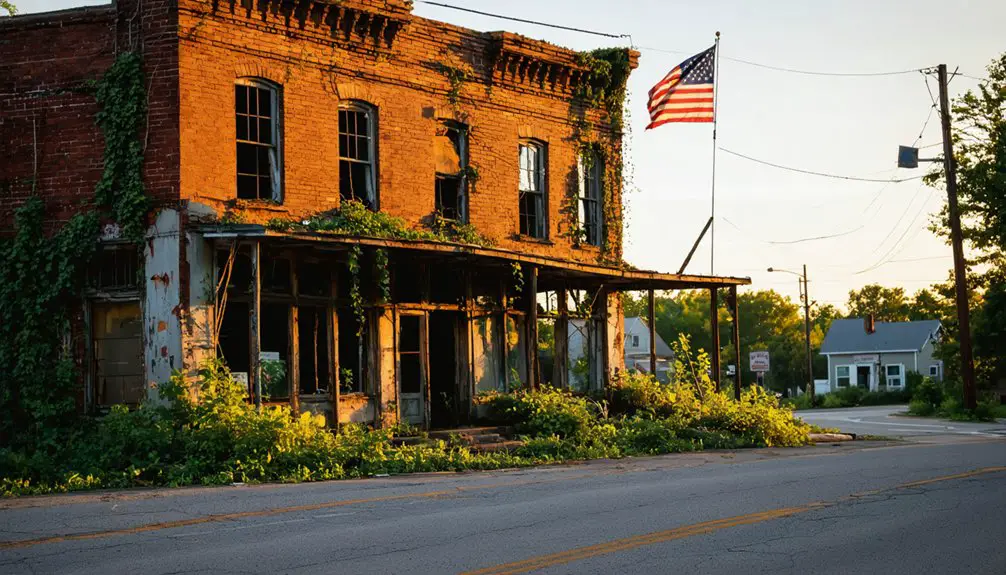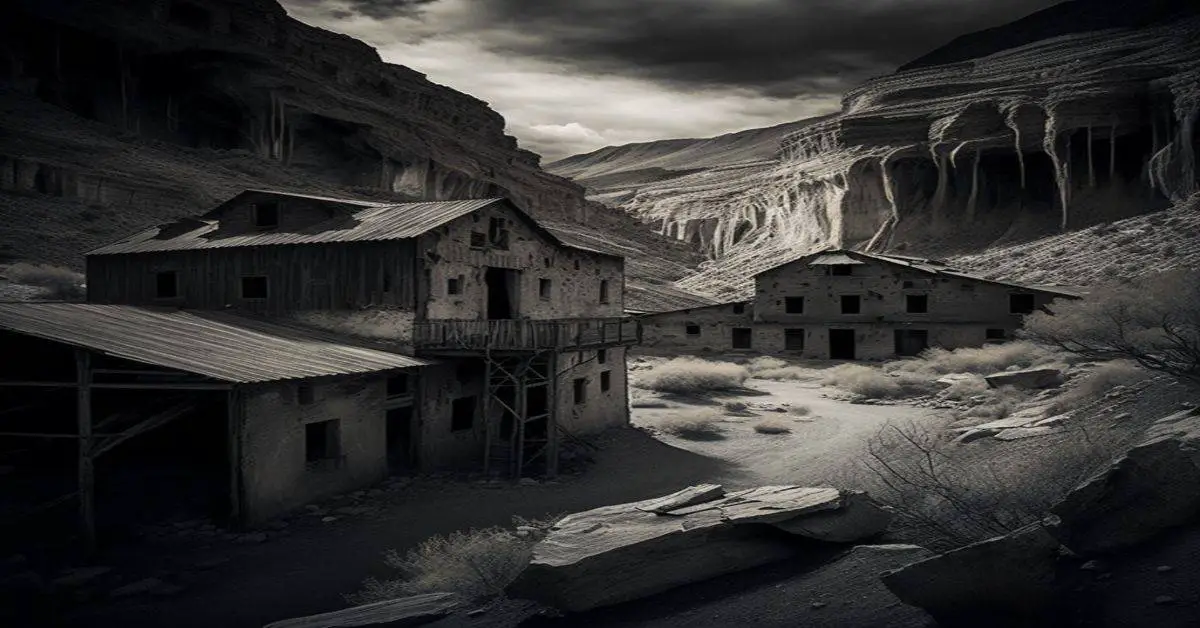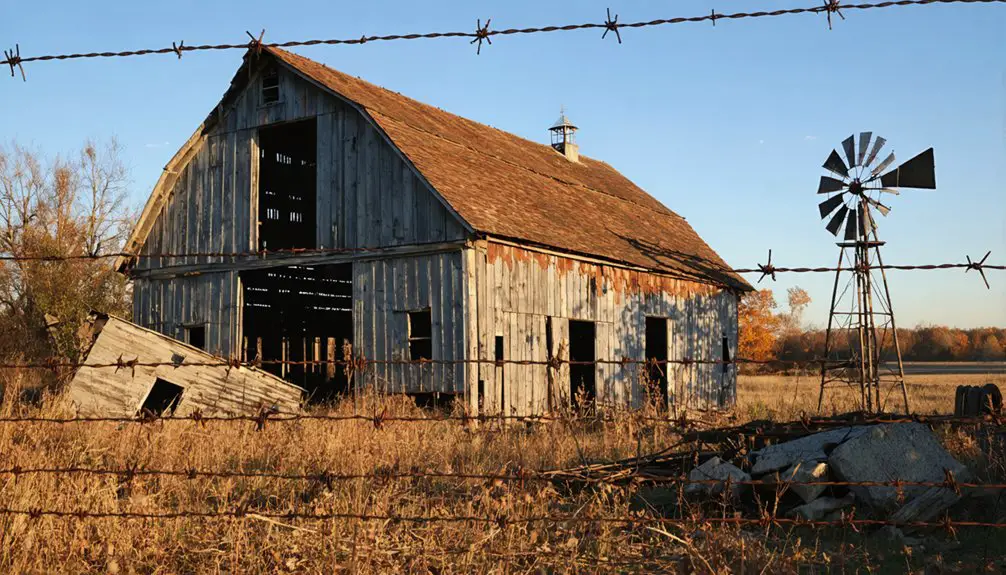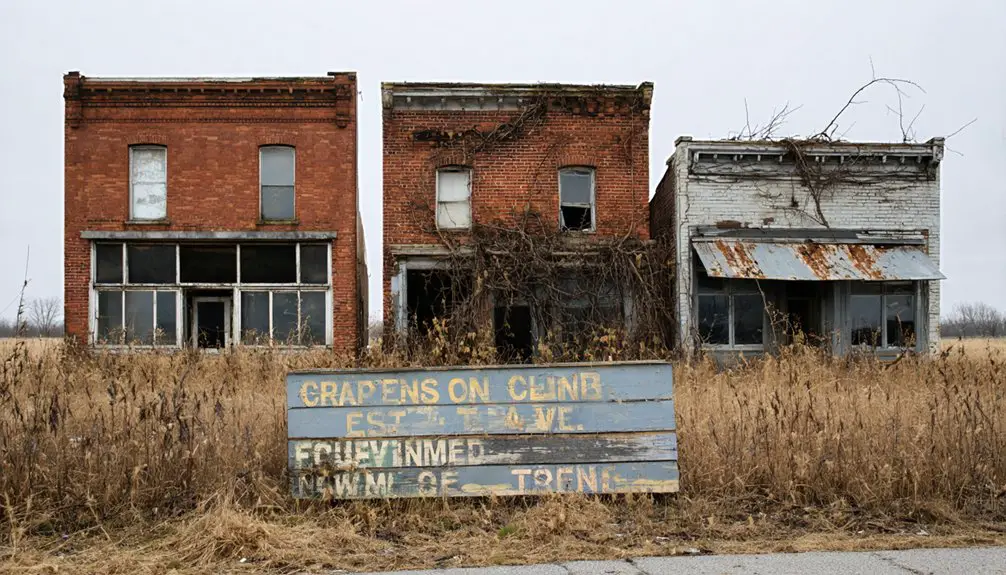You’ll find Findlay Ghost Town in Ohio, a meticulously recreated 1880s Western settlement established by Harry Gatliff in the 1950s. What began with a single log cabin grew into an immersive historical attraction drawing up to 30,000 annual visitors in its peak during the 1960s. While visitor numbers declined after Gatliff’s passing in the early 2000s, the site now hosts seasonal markets, craft shows, and haunted events. The ghostly tales and unexplained phenomena from its authentic period buildings beckon further exploration.
Key Takeaways
- Findlay Ghost Town was established in the 1950s by Harry Gatliff, recreating an authentic 1880s Western settlement with period-specific buildings.
- The site attracted up to 30,000 annual visitors during its peak in the 1960s, offering immersive frontier life experiences.
- Paranormal activity reports center around the saloon and blacksmith shop, with visitors experiencing unexplained phenomena during nighttime events.
- The Ghost Town now primarily functions as an event venue, hosting seasonal markets, craft shows, and popular Halloween attractions.
- Living history experiences and educational programs showcase Ohio’s pioneer heritage through authentic architectural replicas and traditional demonstrations.
The Birth of a Western Dream
While many frontier settlements emerged haphazardly, Findlay’s birth followed a strategic military foundation with the establishment of Fort Findlay during the War of 1812. You’ll find the town’s military heritage deeply embedded in its origins, as Colonel James Findlay’s fort provided the cornerstone for what would become a thriving frontier settlement.
In 1821, you’d have witnessed Joseph Vance and Elnathan Corry laying out the town lots, transforming military pragmatism into civilian opportunity. The Benjamin Cox family’s arrival in 1825 marked the beginning of permanent settlement, with early pioneers repurposing fort blockhouses into homes. The view from their home featured dense forest and underbrush. Today, the town’s sporting legacy continues through the Findlay Freedom hockey team.
Wilson Vance’s careful town planning, though covering less than a square mile, created a framework for freedom and growth amid the challenging Great Black Swamp terrain.
Step Back in Time: The 1880s Experience
From its military origins, Findlay evolved into something unexpected – a carefully crafted window into America’s frontier past.
As you walk the dusty streets, you’ll find yourself transported to an authentic 1880s Western settlement, where historical authenticity meets immersive storytelling. The meticulously reconstructed buildings – from rustic saloons to bustling blacksmith shops – showcase period-specific craftsmanship and design. Founded by Harry Gatliff in the 1950s, this unique attraction began with a simple log cabin purchase. The town features distinctive boarded-up windows that add to its ghostly atmosphere.
Inside, you’ll discover interiors furnished with genuine 19th-century artifacts that bring frontier life into sharp focus. The town’s wooden sidewalks and weathered facades aren’t just for show; they’re staging grounds for interactive experiences that connect you directly with Ohio’s pioneer heritage.
Through seasonal events, craft fairs, and educational programs, you’ll experience firsthand how settlers lived, worked, and built communities in the American frontier.
Peak Years and Tourist Adventures
During its peak years in the late 1960s, Findlay Ghost Town drew an impressive 30,000 visitors annually who sought an authentic taste of frontier life. The site remains accessible today through 419-673-7783 for those interested in visiting.
You’d find yourself immersed in a meticulously recreated 1880s Western town, complete with historically accurate buildings and period-specific artifacts. The visitor engagement peaked through special events like craft shows and fall festivals, while the “Ghost Town Picayune” newspaper kept both tourists and locals connected to the site’s vibrant community. Originally established by Mr. Galitza in 1959, the attraction featured an impressive collection of historical relics and buildings.
- Experience life as a frontier settler through interactive exhibits and preserved antique furnishings
- Explore authentically designed structures including the saloon, general store, and blacksmith shop
- Participate in seasonal events that blend historical accuracy with entertainment, from summer markets to Halloween haunts
Legends and Ghostly Tales
As Ghost Town evolved beyond its historical replica roots, it developed a rich tapestry of supernatural folklore that now defines its modern identity.
You’ll find the most compelling ghost stories centered around the saloon and blacksmith shop, where visitors report shadowy figures and unexplained sounds, particularly during nighttime events.
Paranormal investigators have documented electromagnetic anomalies and temperature drops throughout the property, lending credence to the spectral sightings that date back to the late 1970s.
Scientific evidence of ghostly activity has mounted since the 1970s, with measurable changes in electromagnetic fields and temperature patterns.
The aging structures, some deteriorating with time, create an authentically eerie atmosphere that enhances these supernatural experiences. The site’s popular haunted experiences draw visitors year-round who seek thrilling encounters with the unknown.
While the site began as a 1950s tribute to the 1880s Wild West, it’s now equally renowned for its haunted reputation, drawing generations of families seeking both historical education and spine-tingling encounters.
From Bustling Streets to Quiet Paths
If you’d visited Findlay’s Ghost Town during its heyday in the 1950s through the 1970s, you would’ve encountered up to 30,000 seasonal visitors exploring the bustling replica of an 1880s Western settlement.
The attraction’s vibrant atmosphere, complete with period-specific buildings and antique furnishings, gradually faded after founder Harry Gatliff’s death in the early 2000s.
Today, the once-animated streets have grown quiet, with the site primarily serving as a venue for special events and seasonal gatherings rather than a daily tourist destination. The location now hosts popular haunted attractions during the Halloween season.
Past Vibrant Tourist Life
Once a vibrant destination in Ohio’s tourism landscape, Findlay’s Ghost Town captured the imagination of 30,000 visitors per season during its peak years.
You’d experience the authentic charm of the 1880s Wild West through meticulously crafted buildings, creating tourist nostalgia that resonated throughout the region. The attraction’s economic impact extended beyond its wooden facades, as craft shows and seasonal events drew crowds that supported local businesses. Today, visitors explore these crumbling buildings as nature slowly reclaims the historic site.
- The 28-building complex featured immersive experiences like cowboy shoot competitions and haunted tours.
- Antique-filled structures and period-specific artifacts transformed routine visits into living history.
- Family traditions formed around seasonal events, fostering a deep connection between visitors and the recreated frontier spirit.
Silent Echoes Remain Today
Today, the bustling streets that once echoed with the footsteps of 30,000 seasonal visitors have transformed into quiet pathways through Findlay’s Ghost Town.
You’ll find silent reflections of the past in the weathered storefronts and Boot Hill Cemetery, where authentic grave markers stand as evidence to frontier life.
While the site isn’t truly abandoned, historical echoes resonate through the replica 1880s buildings during quiet periods between seasonal events.
Natural overgrowth has softened the townscape, creating a more secluded atmosphere.
Located at 10630 Co Rd 40, this recreated western town continues to draw visitors seeking a taste of frontier history.
You can still experience glimpses of its former glory during Halloween haunts, craft fairs, and community celebrations.
These occasions bring temporary life to the otherwise tranquil setting, where educational programs and reenactments keep the spirit of the Old West alive for modern audiences.
Modern-Day Revival and Events
You’ll find a bustling calendar of seasonal markets and festivals at Findlay’s Ghost Town, where craft shows and flea markets now animate the once-quiet streets throughout summer and fall.
The site’s revival has transformed it into a vibrant community hub, hosting cultural gatherings that merge historical education with entertainment through interactive experiences like Wild West reenactments and general store demonstrations.
While maintaining its historical authenticity, the venue serves as a platform for local artisans and vendors, fostering economic growth through tourism and creating a space where both residents and visitors can connect with the region’s cultural heritage.
Seasonal Markets and Festivals
Findlay’s vibrant market scene comes alive through four distinct seasonal events that have transformed this historic area into a bustling hub of commerce and community gatherings.
You’ll find the Hancock County Farmers’ Market running Thursdays from May through October, showcasing fresh local produce and handmade goods. The Springtime in Ohio Craft Show attracts regional artisans, while Flag City BalloonFest serves as the crown jewel of summer festivals with its multi-day celebration and vendor marketplace.
- Seasonal markets have revitalized local commerce through modern payment systems and diverse vendor participation.
- Community festivals blend traditional heritage with contemporary attractions, from hot air balloons to artisanal crafts.
- Regional event coordination creates sustainable vendor networks that strengthen Findlay’s market presence year-round.
Community Cultural Gatherings
Through a vibrant tapestry of historical reenactments and cultural programming, Ghost Town has emerged as a cornerstone of community engagement in modern-day Findlay.
You’ll experience 1880s Wild West life through staged shootouts and saloon interactions, while events like Johnny Appleseed Days celebrate regional pioneer heritage.
The biannual Ghost Town Craft Show showcases local artisans practicing traditional frontier skills, from woodworking to leathercraft.
Cultural preservation efforts extend to educational programs, where guest speakers and interactive sessions connect you with Ohio’s pioneer history.
Veterans receive special recognition through VETFEST and dedicated tribute ceremonies, blending historical ambiance with civic pride.
These multi-generational gatherings serve as cultural touchpoints, ensuring Ghost Town’s legacy continues through hands-on experiences and community participation.
Preserving Ohio’s Wild West Legacy
While many American frontier towns exist only in history books, Ghost Town Findlay stands as a remarkable tribute to Ohio’s Wild West heritage.
Through meticulous frontier preservation efforts, entrepreneur Harry Gatliff created an authentic 1880s Western settlement that draws thousands of visitors seeking historical education and a taste of frontier life.
You’ll discover a world where saloons, general stores, and blacksmith shops transport you back to Ohio’s pioneering days.
- Experience living history through expertly crafted structures that replicate the genuine architectural style of the American frontier
- Explore the intersection of entertainment and education as you walk through this carefully preserved slice of Western heritage
- Connect with Ohio’s role in westward expansion through hands-on demonstrations and immersive historical experiences
Frequently Asked Questions
What Happened to Harry Gatliff’s Family After His Passing?
You’ll find the Gatliff legacy remains shrouded in mystery, as family struggles appear to have led them away from the public eye, with no documented records of their activities after Harry’s departure.
How Much Did It Cost to Visit Ghost Town During Its Peak?
While you’d find 30,000 visitors during peak attendance years, exact admission prices aren’t documented for the 1950s-60s. Evidence suggests you’d likely pay minimal fees, with small charges for individual attractions.
Were Any Original Western Artifacts Brought From Actual Frontier Towns?
You’ll find limited evidence of authentic frontier artifacts beyond an original log cabin and some donated grave markers. Most items were historically accurate reproductions meant to recreate the Western town’s historical significance.
Did Native Americans Play Any Role in Ghost Town’s Historical Presentations?
Like echoes in an empty canyon, Native heritage exists mainly through static displays of artifacts. You’ll find cultural influences acknowledged through museum exhibits, but there’s no active indigenous representation in performances.
What Transportation Options Were Available for Visitors Without Personal Vehicles?
You’d find limited public transportation options, with no regular bus routes or shuttle services available. Your best bets were hiring taxis, arranging private group transport, or coordinating rides with other visitors.
References
- https://evendo.com/locations/ohio/findlay/landmark/ghost-town-findlay-ohio
- https://taylorplace.seniorlivingnearme.com/blog/ghost-town-in-findlay-ohio-a-unique-adventure-for-seniors
- https://wsharing.com/WSphotosGhostTown.htm
- https://visitfindlay.com/places/ghost-town/
- https://ohioghosttowns.org/hancock-county/
- https://en.wikipedia.org/wiki/Findlay
- https://visitfindlay.com/early-findlay-residents/
- https://findlayohiohistory.weebly.com
- https://visitfindlay.com/early-history-fort-findlay/
- https://ohiogenealogyexpress.com/hancock/hancockco_hist_1886/hancockco_hist_1886_pg_512_pt_iii_chapt_xxvii_findlay.htm



